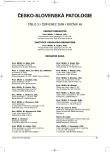Systemic Amyloidoses in Renal Biopsy Samples
Authors:
L. Bauerová 1; E. Honsová 1,2; R. Ryšavá 3; C. Povýšil 1
Authors place of work:
Ústav patologie, 1. LF UK a VFN, Praha
1; Pracoviště klinické a transplantační patologie, IKEM, Praha
2; Klinika nefrologie, 1. LF UK a VFN, Praha
3
Published in the journal:
Čes.-slov. Patol., 45, 2009, No. 3, p. 64-68
Category:
Původní práce
Summary
The kidneys are one of the most frequent sites of amyloid deposition during systemic AL, AA, and several hereditary amyloidoses. Distinguishing between different forms of amyloids is clinically important because of their different treatment.
Material and methods:
We present a 5-year retrospective study of amyloidoses diagnosed in renal biopsy samples. The classification of amyloidosis was made by immunofluorescence and immunohistochemical staining with antibodies to kappa and lambda immunoglobulin light chains, and for serum amyloid A protein.
Results:
From January 2003 to December 2007, 996 renal biopsy samples from one centre were evaluated. Amyloidosis was diagnosed in 62 samples (6.2%); 33 (53.2%) were classified as AL and 25 (40.3%) as AA amyloidosis. Four cases have remained unclassified. We did not identify any difference in the distribution of deposits among cases with AL and AA amyloidosis, respectively. The majority of patients underwent the renal biopsy due to severe proteinuria or nephrotic syndrome. Three patients had very low proteinuria, less than 0.5g/day. Diagnosis of amyloidosis was suspected by nephrologists in 48 patients (77.4%).
Conclusion:
Diagnosis of amyloidosis involves detection of amyloid deposits and classification of the amyloid form, which represent the basic step for appropriate therapy. Alltogether it is not an easy task for pathologists, and with the emergence of markedly different treatments depending on the specific type of amyloid, the precise typing is of increasing clinical importance and should be performed with great care. Immunofluorescence can be very useful in daily practice for classification of the type of amyloidosis.
Key words:
systemic amyloidosis - diagnosis of amyloidosis - renal amyloidosis
Zdroje
1. Anjali, A., Satoskar, A.A., Burdge, K. et al..: Typing of amyloidosis in renal biopsies. Arch. Pathol. Lab. Med., 131, 2007, s. 917–922.
2. Comenzo, R.L., Zhou, P., Fleisher, M., et al.: Seeking confidence in the diagnosis of systemic AL (Ig light-chain) amyloidosis: patients can have both monoclonal gammopathies and hereditary amyloid proteins. Blood, 107, 2006, s. 3489-3491.
3. Dember, L.M.: Amyloidosis-associated kidney disease. J. Am. Soc. Nephrol., 17, 2006, s. 3458–3471.
4. Jacobson, D.R., Pastore, R.D., Yaghoubian, R., et al.: Variant-sequence transthyretin (isoleucine 122) in late-onset cardiac amyloidosis in black Americans. N. Engl. J. Med., 336, 1997, s. 466–473.
5. Lachmann, H.J., Booth, D.R., Booth, S.E. et al.: Misdiagnosis of hereditary amyloidosis as AL (primary) amyloidosis., N. Engl. J. Med., 346, 2002, s. 1786–1791.
6. Mai, H.L., Sheikh-Hamad D., Herrera G.A.: Immunoglobulin heavy chain can be amyloidogenic. Am. J. Surg. Pathol., 27, 2003, s. 541–545.
7. Olafsson, I., Grubb, A.: Hereditary cystatin C amyloid angiopathy. Amyloid, 7, 2000, s. 70–79.
8. Picken, M.M.: New insights into systemic amyloidosis: the importance of diagnosis of specific type. Curr. Opin. Nephrol. Hypertens., 16, 2007, s. 196–203.
9. Ryšavá, R.: AL Amyloidosis with renal involvement. Kidney Blood Press. Res., 30, 2007, s. 359–364.
10. Sanchorawala, V.: Light-chain (AL) amyloidosis: diagnosis and treatment. Clin. J. Am. Soc. Nephrol., 1, 2006, s. 1331–1341.
11. Veeramachaneni, R., Gu, X., Herrera, G.A.: Atypical amyloidosis: diagnostic challenges and the role of immunoelectron microscopy in diagnosis. Ultrastructural Pathology, 28, 2004, s. 75–82.
Štítky
Patologie Soudní lékařství ToxikologieČlánek vyšel v časopise
Česko-slovenská patologie

2009 Číslo 3
Nejčtenější v tomto čísle
- Neuroendokrinní nádory trávicího ústrojí – historie a současnost
- Folliculitis perforans Kazuistický prípad a diferenciálna diagnostika choroby
- Doc. MUDr. Viera Povýšilová, CSc. – ohlédnutí za životní dráhou
- Systémové amyloidózy v biopsiích ledvin
